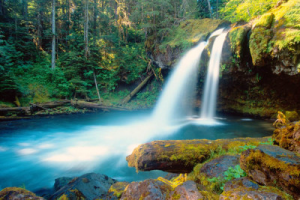
By Roddy Scheer
There just may be some truth to the rumor that being around waterfalls can uplift your mood, thanks to the so-called “negative ions” pervasive in such environments. The collision of water molecules with each other, such as at a waterfall or an ocean beach, causes the water to become positively charged, and the surrounding air to be negatively charged.
According to Pierce J. Howard, a Ph.D. and author of The Owner’s Manual for the Brain: Everyday Applications from Mind-Brain Research, it makes sense that waterfalls can make you feel good, given that negative ions hitting our bloodstream can produce biochemical reactions linked to alleviating depression, relieving stress, and boosting energy.
“High concentrations of negative ions are essential for high energy and positive mood,” he reports. “Negative ions suppress serotonin levels in much the same way that natural sunlight suppresses melatonin. Hence the invigorating effect of fresh air and sunshine and the correspondingly depressed feelings associated with being closed in and dark.”
“The atmosphere we breathe normally is full of positive and negative ions,” he adds. “Air-conditioning, lack of ventilation, and long dry spells remove negative ions.”
“The best ratios of negative to positive ions are associated with waterfalls and the time before, during, and after storms,” says Howard. “The worst are found in windowless rooms and closed, moving vehicles.”
In another recent study, researchers sampled the effects of nature on 537 University of Rochester students in both real and imagined situations, and found that individuals who spent time outdoors — or even just imagined themselves in nature — consistently experienced higher energy levels and increased feelings of happiness. Study participants who spent just 20 minutes outdoors a day experienced significant increases in energy levels as well as noticeable mood boosts. Even indoor plants played a role in helping study participants feel more energized.
Another way to look at it would be to consider our sedentary, indoor lifestyle to be a drain on our energy reserves and taxing to our mood and general sense of well-being. In the landmark 2005 book Last Child in the Woods, Richard Louv coined the term “nature deficit disorder” to explain how our lack of time outdoors has led to behavioral problems in kids and adults alike. Louv’s prescription? Spend more time outdoors (away from screens) interacting with nature and each other.
In case you needed another reason to get up off the couch or office chair and out into the woods on a waterfall hike, now you have it. You’ll be sharper. You’ll be more productive. You’ll be invigorated. And you’ll be happier.
Roddy Scheer is the editor of EarthTalk.org and author of the recently released Hiking Waterfalls in Washington: A Guide to the State’s Best Waterfall Hikes
. Check out his Waterfall Hike of the Week and follow his other adventures on his blog, roddyssey.com…








